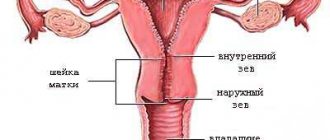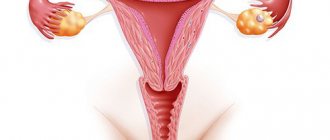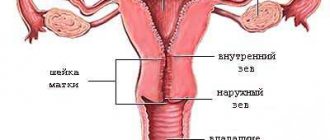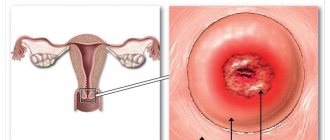Cervical erosion is a common gynecological disease. This is the name for damage to epithelial tissue localized in the vaginal part of the cervix. Usually this disease develops against the background of another disease - inflammatory or infectious, due to hormonal disorders. Often the course of the disease is asymptomatic and pathology can only be noticed during a routine examination. In itself, this disease does not pose a serious threat to health, but if left untreated, it is considered a risk factor for the development of tumors, including malignant ones. Diagnosis is quite simple - only a gynecological examination and colposcopy may be sufficient. Treatment is removal of the affected tissue.
At CELT you can get advice from a gynecologist.
- Initial consultation – 3,000
- Repeated consultation – 2,000
Make an appointment
What it is?
Erosion is a disease that is characterized by pathology of epithelial tissue. Cervical erosion occurs in every seventh woman and is one of the extremely common gynecological diseases. Flat epithelium, localized in the vaginal area of the cervix, should normally consist of homogeneous pale cells.
If an infectious process develops in the genital area, mechanical damage occurs, a constant inflammatory process is observed, then erosion appears. Without treatment, pathological changes continue to develop, epithelial cells change more rapidly, and there is a risk of the formation of polyps and tumors. In the long term, this leads to the appearance of tumors that are more difficult to treat.
Diathermocoagulation
This is a method of tissue cauterization, which uses a high frequency current of up to 3-5 amperes. This allows for extensive and deep coagulation of the affected area. This technique can also be used for endometriosis, condylomas and early and moderate dysplasia.
The advantages of the procedure are its accessibility and prevalence. Almost every specialized clinic has equipment for treating erosion using current. But the doctor’s competence plays a very important role in the procedure, since it is he who controls the depth of tissue destruction. If diathermocoagulation is carried out incorrectly, a number of difficulties may arise :
- bleeding (both during surgery and during the rehabilitation period);
- development of endometriosis;
- exacerbation of inflammatory processes;
- the appearance of scars;
- menstrual irregularities.
Causes of the disease
There are many of them, as well as risk factors. Any changes in the mucous membrane of the cervix can lead to the development of erosion. Such changes occur in diseases of the genitourinary system, after childbirth, after artificial termination of pregnancy, and are observed during hormonal diseases. Often, sexually transmitted diseases lead to erosion - their pathogens enter the body through the mucous membrane, damaging the epithelial tissue.
There is no specific age category susceptible to this disease. Erosion can develop both in adolescence and in old age.
Types of disease
Depending on when and by what mechanism the disease develops, there are several main types of erosion:
- True.
- Pseudo-erosion.
- Congenital.
They differ in causes and mechanisms of development, as well as in the course of the disease.
Signs of true erosion:
- It is formed due to damage to the epithelial tissue in the area of the external os - this is the place where the vaginal part of the cervix is directly connected to the vagina.
- Inflammation occurs and damaged tissues bleed.
- Often develops against the background of endocervicitis. A disease that leads to the release of pathological mucus from the cervical canal, which irritates the tissue of the cervix.
- Damaged tissues are brightly colored and turn red.
- Colposcopy is usually sufficient for diagnosis; microscopy of pathological tissue may be required for final confirmation.
Pseudo-erosion is the next phase into which true erosion passes. The true one heals within two weeks, during this process the flat epithelium is replaced by cylindrical epithelium - that is, tissue replacement occurs. New cells are more saturated in color. Most erosions are diagnosed at this stage - at the first stage of healing.
However, during the healing stage, the pathology continues to develop: normal tissue is not formed. The columnar epithelium grows, and it grows not only on the surface, but also in depth. As a result, cysts are formed filled with glandular secretions. If many cysts develop, then the disease during visual examination can be confused with polyposis. If the cysts are large, then cervical hypertrophy develops - it increases in size. Cysts can be different, both in size and shape, and in content.
If left untreated, the pathology remains in this form for several months or even years. Cysts can grow or, conversely, not grow. Pseudo-erosion is a constant source of inflammation, which causes unpleasant symptoms to develop.
The inflammation may subside on its own, in which case the process of normal tissue growth will begin. This occurs rarely, so in most cases special treatment is required. After eliminating the inflammatory process, the second stage of healing begins: the formation of squamous epithelium. The danger is that with prolonged absence of therapy, erosion can develop into dysplasia, which is considered a precancerous condition.
Another type of this disease is congenital erosion of the cervix, which develops during embryonic development. As a rule, such pathology is detected quite early, in childhood or adolescence. Often congenital erosion goes away on its own. This is a harmless form, as it does not lead to the formation of malignant tumors.
Is it painful to cauterize erosion?
When it is necessary to cauterize erosion, a woman is faced with the question of choosing a method. Most patients focus not only on the cost of the procedure, but also on the pain of a particular method, as well as the duration of the healing process and possible complications.
The pain of cauterization depends on several factors:
- Dimensions of the eroded area. The larger the erosion, the longer the treatment will be required. Accordingly, the procedure time and discomfort increase.
- The patient's individual pain threshold. The more a woman feels pain, the more unpleasant she will find the sensations during cauterization.
- Choice of anesthesia. The procedure is carried out without the use of painkillers and anesthetics. But sometimes anesthesia is used - both local and general. For some types of cauterization, such as chemical coagulation, anesthetics are used.
- Type of cauterization. Laser and radio wave removal, when performed correctly, are painless methods.
- When repeated cauterization takes place (in case of relapse of erosion), the sensations will be stronger. This is due to thinning of the epithelium or its incomplete restoration after the first procedure.
In general, the sensations can be described as non-intense, pulling, cramping.
Diagnostics
Diagnostics includes examination, instrumental methods and laboratory tests. Diagnosis is often delayed due to the fact that in the absence of pronounced symptoms, patients simply do not consult a doctor. If there are symptoms, they are usually associated with the disease that provoked the development of erosion. Thus, the disease can be detected in a timely manner only by undergoing preventive examinations. A standard visual examination of the cervix allows the gynecologist to suspect the development of erosion, and colposcopy is used to confirm the diagnosis - this method allows one to examine pathological tissues under magnification.
If the doctor suspects that the process of development of malignant tumors has already begun, then a study such as extended colposcopy is used. First, the affected area is treated with an iodide solution, and then examined under magnification. If dysplasia is suspected, a biopsy may be required for histological analysis in the laboratory.
Popular questions
A year ago, cervical erosion was discovered.
2 cryodestructions were performed. To normalize hormonal levels, COC Jess Plus was prescribed. Now erosion has appeared again. According to the results of cytology CIN 1, leukocytes and erythrocytes are in moderate quantities. Last year's and current PCR tests for HPV, ureaplasma, mycoplasma, and torch infections were negative. The gynecologist prescribed excision followed by sending the tissue for histology. There were no pregnancies, now in the planning stage. I would like to hear an additional answer regarding the need for cervical excision; will this procedure affect conception and natural childbirth? In this situation, it is necessary to know the conclusion of colposcopy, carry out additional sanitation of the genital tract and undergo a “liquid cytology” test, which will confirm or refute the presence of mild dysplasia. If the conclusion is repeated, then it is better to plan pregnancy and periodically monitor the smear for oncocytology, rather than carry out surgical treatment.
They cauterized the cervical erosion. In the second week I started bleeding and have been bleeding periodically for two weeks now. It smears, not much, but it leaves a stain on the pad, is it normal that there is bleeding?
The appearance of discharge mixed with blood after the operation is normal, since during this period the scab (a crust from a wound on the cervix) is rejected. To ensure better healing of the surface at the moment, I recommend using Ginocomfort gel with mallow extract. This will ensure gentle epithelization and prevent inflammation and bleeding.
Hello! My daughter is suspected of having erosion; she has not given birth yet. They prescribed Klion D suppositories. After she put them on, 2 hours passed, she went to the toilet and a burning sensation appeared inside the vagina. What can be done to relieve this discomfort? Can I continue to try taking this drug? Hello! To relieve the symptoms of burning after urination, you can perform hygiene with an antiseptic or intimate gel with an anti-inflammatory effect, for example Gynocomfort intimate gel. This will not only eliminate discomfort, but also complement the anti-inflammatory effect. You should continue to use the suppositories, and if similar manifestations recur, consult your doctor.
I was diagnosed with cervical erosion, the first gynecologist did not give me a conclusion. I learned this from the second gynecologist (the first gynecologist said cauterization, the second after childbirth). Cervical canal scraping revealed (1) HPV 31 q 1.8×10*6 HPV 31 in ye Hybrid Capture 12; (2) HPV 58 q 1.0×10*5 HPV 58 in ye Hybrid Capture 0.66 Material capture control 2.0x10*5. and so far 2 infectious diseases have been identified: Mycoplasma sp. (generic); Gardenella vaginalis. Question: I need to do a transvaginal ultrasound. When is the best time to do it? What tests should I take? I’m 28 years old and have no children; I really want to give birth.
Hello!
In your case, you need to start with anti-inflammatory therapy for mycoplasmosis, gardnerellosis and carriage of the Human Papilloma Virus. Then perform a colposcopy and take an oncocytology test. Based on their results, decide on the need to treat cervical erosion before birth. Ultrasound is not performed in this situation. For an accurate diagnosis, contact a specialist
Treatment
Radical treatment is predominantly surgical. But there are situations in which dynamic observation and conservative therapy are preferable.
Basic principles of treatment:
- For congenital pathology, observation is preferable. Removal is required if the pathology develops or symptoms that are unpleasant for the patient are present.
- True and pseudo-erosions require correction of the underlying disease. If, along with the cure of the primary disease, regression of erosion does not occur, then removal is prescribed.
- If there are signs of infectious inflammation, the pathogens are first eliminated (most often these are microorganisms that cause the development of sexually transmitted diseases).
- If the erosion is in the active stage (true), then surgery is not indicated. Gentle treatment methods are used, aimed primarily at eliminating unpleasant symptoms.
Surgical treatment using modern means is aimed at destroying the layer of cylindrical cells. After this, rejection occurs, and the growth of normal squamous epithelium begins at the site of the pathology.
Basic surgical methods:
- thermocoagulation
Thermocoagulation is a method that is based on cauterization under the influence of current. The disadvantage of this method is the possibility of scar formation. For this reason, thermocoagulation is offered only to patients who do not plan to have children in the future. Complete healing takes up to three months.
- use of laser
Laser cauterization requires careful sanitation. This method is painless and leaves no scars. Complete regeneration takes four weeks.
- Radio wave destruction of erosion is performed using special equipment and has advantages over standard electrocoagulation in the form of healing without scar formation.
- cryodestruction
- Cryodestruction (cryocoagulation)
Cryocoagulation is destruction by cold using liquid nitrogen.
When prescribing surgical treatment, a study is required to exclude the development of oncology. And if the process of development of a malignant tumor has already begun, removal can provoke tumor growth.
Prevention consists of timely treatment of inflammatory and infectious diseases, as well as regular visits to the gynecologist and preventive examinations. Erosion can be detected during a routine examination by a gynecologist, and treatment should begin as early as possible.
In the multidisciplinary CELT clinic, you can undergo a complete diagnosis, after which the doctor will develop a treatment regimen, if necessary. It’s easy to be healthy – together with attentive doctors and modern treatment methods.
Conservative therapy
This technique involves identifying the cause of the disease and directing treatment to eliminate it. As practice shows, in most cases, after eliminating the cause of the pathology, erosion disappears.
In this case, the patient is prescribed a course of antibiotics, anti-inflammatory drugs or immunomodulators. The doctor can also recommend traditional medicine recipes that are a complement to treatment.
This method is universal and suitable for all women, including nulliparous girls. Its only drawback is the likelihood of relapse.
Our services
The administration of CELT JSC regularly updates the price list posted on the clinic’s website. However, in order to avoid possible misunderstandings, we ask you to clarify the cost of services by phone: +7
| Service name | Price in rubles |
| Colposcopy | 1 800 |
| Taking a biopsy for diseases of the cervix using radiosurgery (excluding the cost of histological examination) | 5 000 |
| Coagulation using radiosurgery in the treatment of cervical diseases | 3 000 |
| Coagulation using radiosurgery in the treatment of cervical diseases with simultaneous biopsy taking (excluding the cost of histological examination) | 7 500 |
| Appointment with a surgical doctor (primary, for complex programs) | 3 000 |
All services
Make an appointment through the application or by calling +7 +7 We work every day:
- Monday—Friday: 8.00—20.00
- Saturday: 8.00–18.00
- Sunday is a day off
The nearest metro and MCC stations to the clinic:
- Highway of Enthusiasts or Perovo
- Partisan
- Enthusiast Highway
Driving directions






